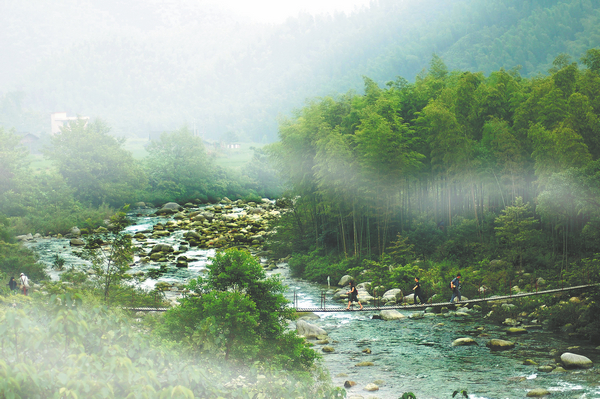
 Media Center
Media Center

Visitors trek in the Lijiang River Source Grand Canyon in Guangxi Zhuang autonomous region, which is known for its karst landscape. CHINA DAILY
Mao'er mountain, inside a reserve that houses 2,484 plant species and 345 wild vertebrates, is absolutely off the beaten track.
"Guilin is such a magical place that no matter how many times you visit it, there is always something new to be discovered," said Jiang Zhengtao, a veteran tour guide at the world-class tourism destination in south China's Guangxi Zhuang autonomous region, widely known for its karst landscape.
For those who don't like crowded places, Jiang recommends Mao'er mountain, which sounds obscure even to domestic visitors, as it is absolutely off the beaten track.
Mao'er mountain, whose peak stretches like a crouching cat, is also called Cat mountain according to records dating back to the Qing Dynasty (1644-1911). The dominant peak, rising 2,141.5 meters, is the tallest in South China. "It is a perfect place to see the sunrise. When bathed in the morning sunlight, every inch of you will feel refreshed," said Jiang, the 40 year-old guide.
The mountain is the headstream of the beautiful Lijiang River. Mao'er mountain received over 100,000 tourists last year, mainly from Guangxi and Guangdong province.
"It is not as popular as the iconic Lijiang River in Guilin, but an increasing number of visitors favor it because of the fresh air, fewer visitors, and the plain and idyllic lifestyle of the local villagers," said Jiang.
Muhammed Jabbar Adeyemi a Nigerian teacher at the University of Electronic Technology in Guilin, recalled his first visit to the mountain in the summer of 2016. "It's a beautiful and scenic place where the hotels are mostly built of wood atop rocks," he said. "I used to have dinner by the riverside while watching the sunset, which I enjoyed a lot. I have always wanted to return here."
Some 110 kilometers away from the urban areas of Guilin, the scenic mountainous area, spread across 17,008 hectares, is within the Mao'er mountain National Nature Reserve, which spans the three counties of Xing'an, Ziyuan and Longsheng.
The reserve houses 2,484 species of the vascular plants known to man, including national first-class protected wild plants and 14 national second-class protected wild plants, such as the Chinese tulip tree, and the horse-tail tree.
There are 345 species of wild vertebrates, including 12 national first-class protected wild animals, namely leopard, clouded leopard, white-necked long-tailed pheasant, dwarf musk deer, Chinese pangolin, Xing'an salamander, golden-fronted fulvetta, yellow-breasted bunting, the jackal, large Indian civet, small Indian civet, and Asian golden cat, and 60 national second-class protected wild animals, such as the Chinese giant salamander, the Tibetan macaque, and the Asian black bear.
The famous Chinese hemlocks here — 500 to 1,000 years old — are considered the most precious treasure of the Mao'er mountain.
As a species that survived the Ice Age, the Chinese hemlock, together with the dawn redwood and the maidenhair tree, is known as "a living fossil". And so is the Xing'an salamander. This salamander species is unique to the alpine wetlands with an elevation of over 1,900 meters in the reserve.
The reserve was founded in 1976 and was designated as national level reserve in 2003. In 2011, it became a member of the World Network of Biosphere Reserves with the approval of United Nations Educational Scientific and Cultural Organization. "You can't find a better place for teenagers to learn life's lessons or researchers to conduct their biodiversity study," said Jiang with pride.
The huge area of the virgin forest makes it vital for the conservation and study of nature. Besides, it's a place where the Yao people and the Miao people reside, thus diversified ethnic cultures can be found.
Moreover, it lies along the ancient passage built by the Chu Kingdom and the Yue Kingdom and connects today's Hunan province and the Guangxi Zhuang autonomous region.
zhangli@chinadaily.com.cn